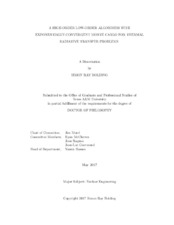| dc.contributor.advisor | Morel, Jim E | |
| dc.creator | Bolding, Simon Ray | |
| dc.date.accessioned | 2017-08-21T14:34:57Z | |
| dc.date.available | 2017-08-21T14:34:57Z | |
| dc.date.created | 2017-05 | |
| dc.date.issued | 2017-02-14 | |
| dc.date.submitted | May 2017 | |
| dc.identifier.uri | https://hdl.handle.net/1969.1/161339 | |
| dc.description.abstract | We have implemented a new high-order low-order (HOLO) algorithm for solving thermal radiative transfer (TRT) problems. Within each discrete time step, fixed-point iterations are performed between a high-order (HO) exponentially-convergent Monte Carlo (ECMC) solver and a low-order (LO) system of equations. The LO system is based on spatial and angular moments of the transport equation and a linear-discontinuous finite-element (LDFE) spatial representation, producing equations similar to the standard S2 equations. The LO solver is fully implicit in time and efficiently converges the non-linear temperature dependence with Newton's method. The HO solver provides a globally accurate solution for the angular intensity to a fixed-source, pure absorber transport problem. This global solution is used to compute consistency terms in the LO equations that require the HO and LO solutions to converge towards the same solution. The use of ECMC allows for the efficient reduction of statistical noise in the solution.
We investigated several extensions of this algorithm. A parametric closure of the LO system was used for the spatial variable, based on local relations computed with the HO solver. The spatial closure improves consistency between the two solvers compared to a standard LDFE spatial discretization of the LO system. The ECMC algorithm has been extended to integrate the angular intensity in time, with a consistent time closure of the LO radiation equations. The time closure increases accuracy in optically-thin problems compared to a backward Euler discretization. Finally, we have applied standard source iteration and Krylov procedures to iteratively solve the LO equations, with linear diffusion synthetic acceleration.
Herein, we present results for one-dimensional, gray test problems. Results demonstrate several desirable properties of this algorithm: the HOLO method preserves the equilibrium diffusion limit, prevents violation of the maximum principle, and can provide high-fidelity MC solutions to the TRT equations with minimal statistical noise. We have compared results with an implicit Monte Carlo (IMC) code and compared the efficiency of ECMC to standard Monte Carlo in this HOLO algorithm. Our HOLO algorithm is more accurate and more efficient than standard IMC. The extent to which this is so is problem-dependent. | en |
| dc.format.mimetype | application/pdf | |
| dc.language.iso | en | |
| dc.subject | residual Monte Carlo | en |
| dc.subject | thermal radiative transfer | en |
| dc.subject | exponentially-convergent Monte Carlo | en |
| dc.subject | hybrid Monte Carlo | en |
| dc.subject | high-order low-order | en |
| dc.title | A High-Order Low-Order Algorithm with Exponentially-Convergent Monte Carlo for Thermal Radiative Transfer Problems | en |
| dc.type | Thesis | en |
| thesis.degree.department | Nuclear Engineering | en |
| thesis.degree.discipline | Nuclear Engineering | en |
| thesis.degree.grantor | Texas A & M University | en |
| thesis.degree.name | Doctor of Philosophy | en |
| thesis.degree.level | Doctoral | en |
| dc.contributor.committeeMember | Ragusa, Jean | |
| dc.contributor.committeeMember | McClarren, Ryan | |
| dc.contributor.committeeMember | Guermond, Jean-LUc | |
| dc.type.material | text | en |
| dc.date.updated | 2017-08-21T14:34:58Z | |
| local.etdauthor.orcid | 0000-0002-8675-4705 | |


